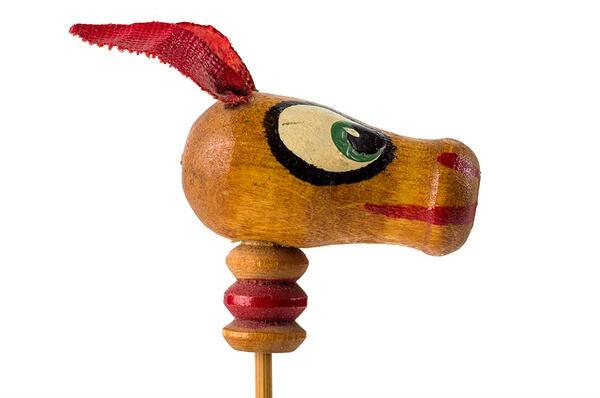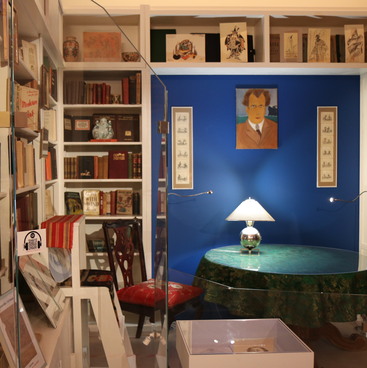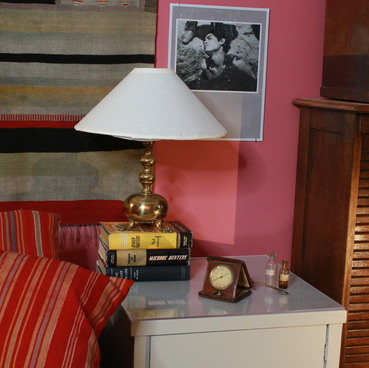The desk is one of the avant-garde pieces of furniture designed by BAuhaus designers in Germany in the mid-1920s. Later, in the 1930s, serial production of this furniture began in Germany, Austria, Czechoslovakia, either under license or with the invention of “analogues”. On this desk there is a mark from the famous branded department store in Prague. That store belonged to Joseph Roth.
It has been established that Bauhaus furniture was already in the apartment on PotYlikha Street in 1940 when the director staged Richard /’rihard/ WAgner’s ValkYrie opera. Evidence supporting this notion is found in the memoirs of the journalist Tatiana Tess, who came to visit Eisenstein. It is suggested that Eisenstein might have purchased the Bauhaus ensemble through an acquaintance in an embassy of a western nation in 1938–1939, or by way of Western Ukraine and Western Belarus when they were occupied by the Soviet forces. At the time, these regions traded goods with CzechoslovAkia.
On the table there are some items that the director used in his work. Eisenstein acquired the light green office lamp with a swivel arm in 1947: the director noticed this Bauhaus-style lamp in the office of the rector of All-Union State Institute of Cinematography and borrowed it from the rector, later All-Union State Institute of Cinematography allowed the director’s widow Pera Atasheva to keep the lamp.
There is a toy donkey near the lamp: there used to be one on the director’s table, only its head was preserved. It is known that as a child Sergei Eisenstein favored movable toys of this kind, with details on tight strings. There were two framed photographs nearby, they stood on the windowsill near the desk: a photo of his father in a wooden frame and a photo with his parents, in which the future director is one year old. The picture was taken at the Riga seaside in 1899. Eisenstein wrote in his memoirs that he felt like a child, “a Riga boy”, until his gray hair. A tray for small office supplies and a bamboo pencil cup are also from the director’s office.
There was also a postcard with Van Gogh’s self-portrait on Eisenstein’s desk. Eisenstein’s study is a fusion of his (and Van Gogh’s) favorite ‘colors of the universe’: sunny yellow walls are complemented by a blue chandelier ball. Eisenstein has crafted the electrolier himself from the XVIII century ‘lomonosovskoye’ glass and a metal base from a XIX century chandelier. His creation was powered by the wonder of XX century: household electricity.
It has been established that Bauhaus furniture was already in the apartment on PotYlikha Street in 1940 when the director staged Richard /’rihard/ WAgner’s ValkYrie opera. Evidence supporting this notion is found in the memoirs of the journalist Tatiana Tess, who came to visit Eisenstein. It is suggested that Eisenstein might have purchased the Bauhaus ensemble through an acquaintance in an embassy of a western nation in 1938–1939, or by way of Western Ukraine and Western Belarus when they were occupied by the Soviet forces. At the time, these regions traded goods with CzechoslovAkia.
On the table there are some items that the director used in his work. Eisenstein acquired the light green office lamp with a swivel arm in 1947: the director noticed this Bauhaus-style lamp in the office of the rector of All-Union State Institute of Cinematography and borrowed it from the rector, later All-Union State Institute of Cinematography allowed the director’s widow Pera Atasheva to keep the lamp.
There is a toy donkey near the lamp: there used to be one on the director’s table, only its head was preserved. It is known that as a child Sergei Eisenstein favored movable toys of this kind, with details on tight strings. There were two framed photographs nearby, they stood on the windowsill near the desk: a photo of his father in a wooden frame and a photo with his parents, in which the future director is one year old. The picture was taken at the Riga seaside in 1899. Eisenstein wrote in his memoirs that he felt like a child, “a Riga boy”, until his gray hair. A tray for small office supplies and a bamboo pencil cup are also from the director’s office.
There was also a postcard with Van Gogh’s self-portrait on Eisenstein’s desk. Eisenstein’s study is a fusion of his (and Van Gogh’s) favorite ‘colors of the universe’: sunny yellow walls are complemented by a blue chandelier ball. Eisenstein has crafted the electrolier himself from the XVIII century ‘lomonosovskoye’ glass and a metal base from a XIX century chandelier. His creation was powered by the wonder of XX century: household electricity.


